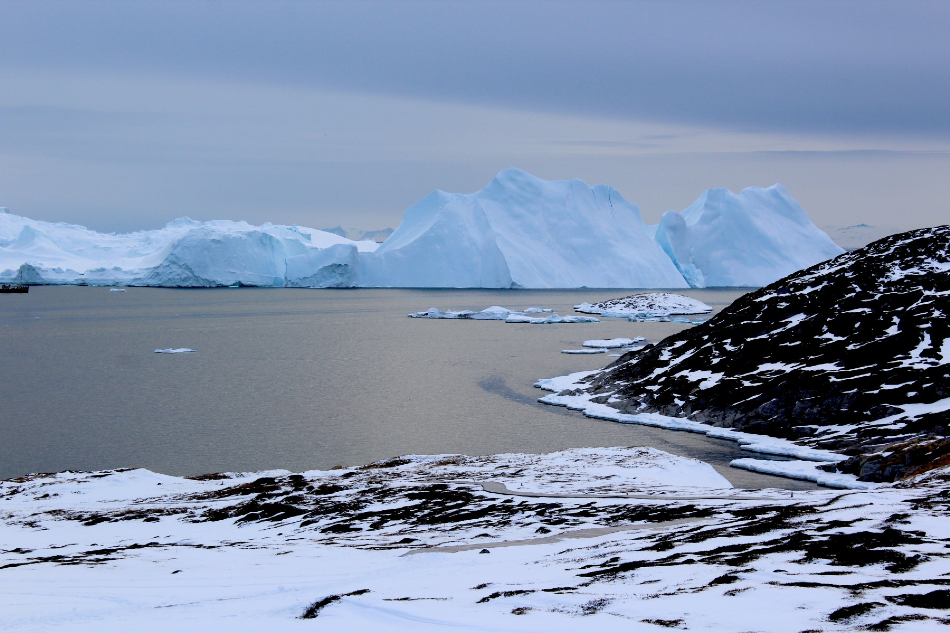Aug 14 2020
The Greenland ice sheet would go on shrinking even if global warming ended immediately, according to a study using almost four decades of satellite data.
 Icebergs near Greenland form from ice that has broken off—or calved—from glaciers on the island. A new study shows that the glaciers are losing ice rapidly enough that, even if global warming were to stop, Greenland’s glaciers would continue to shrink. Image Credit: Michalea King.
Icebergs near Greenland form from ice that has broken off—or calved—from glaciers on the island. A new study shows that the glaciers are losing ice rapidly enough that, even if global warming were to stop, Greenland’s glaciers would continue to shrink. Image Credit: Michalea King.
This latest discovery shows that glaciers in Greenland have passed a sort of tipping point, wherein the snowfall replenishing the ice sheet every year cannot offset the ice that is running into the ocean from glaciers.
The results of the study were recently published in Nature’s Communications Earth & Environment journal.
We’ve been looking at these remote sensing observations to study how ice discharge and accumulation have varied. And what we’ve found is that the ice that’s discharging into the ocean is far surpassing the snow that’s accumulating on the surface of the ice sheet.
Michalea King, Study Lead Author and Researcher, Byrd Polar and Climate Research Center, The Ohio State University
Along with other scientists, King looked at monthly satellite data collected from over 200 huge glaciers flowing into the ocean around Greenland. The team’s observations demonstrated the amount of ice that melts from the glaciers into the ocean or breaks off into icebergs. The researchers also demonstrated the amount of snowfall annually—the way such glaciers get replenished.
The team found that during the 1980s and 1990s, ice calved or melted from glaciers, or snow gained via accumulation, was largely in balance, without affecting the ice sheet. Over those years, the team discovered that the ice sheets usually lost around 450 gigatons (that is, approximately 450 billion tons) of ice annually from the flowing outlet glaciers, which was substituted with snowfall.
We are measuring the pulse of the ice sheet—how much ice glaciers drain at the edges of the ice sheet—which increases in the summer. And what we see is that it was relatively steady until a big increase in ice discharging to the ocean during a short five- to six-year period.
Michalea King, Study Lead Author and Researcher, Byrd Polar and Climate Research Center, The Ohio State University
The team’s analysis eventually revealed that the baseline of that pulse—that is, the proportion of ice being lost every year—began to increase consistently around 2000, so that about 500 gigatons of glaciers were lost every year. At the same time, snowfall did not increase and over the past 10 years, the rate of ice loss from glaciers has remained about the same, which means the ice sheet has been losing ice more quickly than it is being replenished.
Glaciers have been sensitive to seasonal melt for as long as we’ve been able to observe it, with spikes in ice discharge in the summer. But starting in 2000, you start superimposing that seasonal melt on a higher baseline—so you’re going to get even more losses.
Michalea King, Study Lead Author and Researcher, Byrd Polar and Climate Research Center, The Ohio State University
Prior to 2000, the ice sheet would have roughly the same possibility to lose or gain mass every year. But in the present climate, the ice sheet will gain mass in just one out of every century.
According to King, huge glaciers throughout Greenland have retreated around 3 km on average since 1985—“that’s a lot of distance,” she added. The glaciers have reduced so much in size that several of them are sitting in deeper oceans. This implies that more amount of ice is still in contact with water.
Glacier ice is melted by warm ocean water, further making it hard for the glaciers to grow back to their earlier positions. This means that even if humans were to miraculously stop the ongoing climate change, the ice lost from glaciers flowing to the ocean is still likely to surpass the ice gained from the accumulation of snow, and the ice sheet would go on shrinking for some time.
“Glacier retreat has knocked the dynamics of the whole ice sheet into a constant state of loss,” stated Ian Howat, the study’s co-author, professor of earth sciences, and distinguished university scholar at Ohio State University. “Even if the climate were to stay the same or even get a little colder, the ice sheet would still be losing mass.”
In Greenland, shrinking glaciers are posing an issue to the whole planet. The ice melting or breaking off from Greenland’s ice sheets reaches the Atlantic Ocean—and, ultimately, all the oceans in the world.
Greenland’s ice largely contributed to sea-level rise—in 2019, sufficient amounts of ice broke off or melted from the Greenland ice sheet and caused the oceans to increase by 2.2 mm in just a period of two months.
While these results are bleak, according to King, there are definitely silver linings.
“It’s always a positive thing to learn more about glacier environments, because we can only improve our predictions for how rapidly things will change in the future,” she said. “And that can only help us with adaptation and mitigation strategies. The more we know, the better we can prepare.”
This study was financially supported by grants from NASA. Other Ohio State scientists who worked on this study are Salvatore Candela, Myoung Noh, and Adelaide Negrete.
Journal Reference:
King, M. D., et al. (2020) Dynamic ice loss from the Greenland Ice Sheet driven by sustained glacier retreat. Communications Earth & Environment. doi.org/10.1038/s43247-020-0001-2.